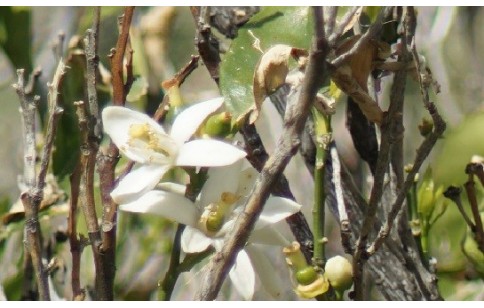- Code : #0552 S 20 mg
- Formula : C₁₂H₈O₄
- CAS : 484-20-8
Citrus sinensis
Citrus sinensis or Citrus x sinensis, “Sweet orange” in English and “Oranger” in French, belongs to the Rutaceae botanical family.
Native to Asia, it is a tree that is generally 9-10 m high, cultivated in warm areas like Mediterranean countries, where it is said to have been brought from China.
The sweet fruit is eaten raw, its juice used as a drink or in jellies, ice cream etc; the rind of the fruit is used as a flavouring or in marmalade and cakes, and flowers are made into a tea.
Essential oil is made with its flowers, leaves, young stems and fruit rind.
C. sinensis is consumed all over the world as a source of vitamin C, a powerful natural antioxidant. It has been used traditionally to treat constipation, cramps, colic, diarrhea, bronchitis, tuberculosis, cough, cold, obesity, menstrual disorder, angina, hypertension, anxiety, depression and stress.
The main components of its fruits, peel, leaves, juice and roots are : flavonoids (nobiletin, sinensetin, tangeretin), steroids, hydroxyamides, alkanes and fatty acids, coumarins, peptides, carbohydrates, carbamates and alkylamines, carotenoids, essential oil containing more than 90% limonene and nutritional elements.

- Code : #5016 1 g
- Formula : C₁₀H₁₆O
- CAS : 5392-40-5
- Code : #5082 S 100 mg
- Formula : C₁₀H₁₆
- CAS : 5989-27-5
- Code : #5041 S 100 mg
- Formula : C₁₀H₁₈O
- CAS : 78-70-6
- Code : #5004 S 100 mg
- Formula : C₁₂H₂₀O₂
- CAS : 115-95-7
- Code : #5124 100 mg
- Formula : C₁₀H₁₆
- CAS : 123-35-3
- Code : #1348 S 10 mg
- Formula : C₂₁H₂₂O₈
- CAS : 478-01-3
- Code : #5382 S 100 mg
- Formula : C₁₀H₁₆
- CAS : 7785-70-8
- Code : #5441 S 100 mg
- Formula : C₁₀H₁₆
- CAS : 18172-67-3
- Code : #5062 SA 100 mg
- Formula : C₁₀H₁₆
- CAS : 3387-41-5
- Code : #1278 10 mg
- Formula : C₁₉H₁₈O₆
- CAS : 1168-42-9
- Code : #1326 S 10 mg
- Formula : C₂₀H₂₀O₇
- CAS : 2306-27-6
- Code : #1033 10 mg
- Formula : C₂₀H₂₀O₇
- CAS : 481-53-8














